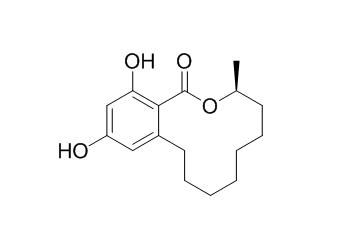De-O-methyllasiodiplodin
De-O-methyllasiodiplodin exhibits radical scavenging, moderate antibacterial, and potential anti-inflammatory effects, it shows moderate suppression effects on induced NO production. De-O-methyllasiodiplodin effectively lowers the blood glucose level in db/db mice possibly via ameliorating the expression of obesity-related pro-inflammatory cytokines, highlighting the potential of the marine natural product as a drug lead for the treatment of metabolic disorders.
Inquire / Order:
manager@chemfaces.com
Technical Inquiries:
service@chemfaces.com
Tel:
+86-27-84237783
Fax:
+86-27-84254680
Address:
1 Building, No. 83, CheCheng Rd., Wuhan Economic and Technological Development Zone, Wuhan, Hubei 430056, PRC
Providing storage is as stated on the product vial and the vial is kept tightly sealed, the product can be stored for up to
24 months(2-8C).
Wherever possible, you should prepare and use solutions on the same day. However, if you need to make up stock solutions in advance, we recommend that you store the solution as aliquots in tightly sealed vials at -20C. Generally, these will be useable for up to two weeks. Before use, and prior to opening the vial we recommend that you allow your product to equilibrate to room temperature for at least 1 hour.
Need more advice on solubility, usage and handling? Please email to: service@chemfaces.com
The packaging of the product may have turned upside down during transportation, resulting in the natural compounds adhering to the neck or cap of the vial. take the vial out of its packaging and gently shake to let the compounds fall to the bottom of the vial. for liquid products, centrifuge at 200-500 RPM to gather the liquid at the bottom of the vial. try to avoid loss or contamination during handling.
Vojnosanit Pregl2016, 75(00):391-391
Evid Based Complement Alternat Med.2016, 2016:4357656
Psychopharmacology (Berl).2020, 10.1007
Evid-Based Compl Alt2020, 7202519:13
Nutrients.2024, 16(14):2267.
Front Pharmacol.2021, 12:761922.
Recent Pat Anticancer Drug Discov.2022, 17(4):416-426.
Food Chem.2024, 452:139555.
Arch Biochem Biophys.2020, 687:108384.
Biosci. Rep.2020, 10.1024
Related and Featured Products
Acta Pharmacol Sin. 2013 Oct;34(10):1325-36.
Marine natural product des-O-methyllasiodiplodin effectively lowers the blood glucose level in db/db mice via ameliorating inflammation.[Pubmed:
23852084 ]
des-O-methyllasiodiplodin (De-O-methyllasiodiplodin,DML) from Cerbera manghas has shown antagonistic activity against mineralocorticoid receptor (MR). Considering the involvement of MR in the insulin tolerance, we attempted to investigate the potential of DML in the treatment of type 2 diabetes mellitus (T2DM).
METHODS AND RESULTS:
In HepG2 and 3T3-L1 cells, both H2O2 and aldosterone markedly stimulates the expression of MCP-1, TNFα, IL-6, p47 and PU.1 genes. Co-treatment with DML (10 μmol/L) significantly reduced the H2O2- or aldosterone-induced expression of these genes. SPR-based assay confirmed the antagonistic activity of DML against the interaction between SRC-1 and MR-LBD. Furthermore, DML decreased aldosterone-induced MR transcriptional activity in a dose-dependent manner. Downregulation of MR with siRNA in the cells prevented or significantly attenuated aldosterone-stimulated expression of these genes, whereas DML did no longer affect the expression of these genes except that of IL-6. Oral administration of DML effectively reduced the levels of blood glucose and glycosylated hemoglobin (HbA1c) in db/db mice. The treatment also rectified the expression of pro-inflammatory factor and ROS-related genes in db/db mice.
CONCLUSIONS:
DML effectively lowers the blood glucose level in db/db mice possibly via ameliorating the expression of obesity-related pro-inflammatory cytokines, highlighting the potential of the marine natural product as a drug lead for the treatment of metabolic disorders.
Nat Prod Res. 2016;30(5):565-9.
A new sesquiterpenoid quinone with cytotoxicity from Abelmoschus sagittifolius.[Pubmed:
26230217 ]
METHODS AND RESULTS:
A new sesquiterpenoid quinone, Acyl hibiscone B (1), together with five known compounds, (R)-lasiodiplodin (2), (R)-De-O-methyllasiodiplodin, (3) dibutyl phthalate (4), (R)-9-phenylnonan-2-ol (5) and hibiscone B (6), was obtained from the stem tuber of Abelmoschus sagittifolius. The structure of compound 1 was elucidated by analysing its (1)H and (13)C NMR, (1)H-(1)H COSY, HSQC, HMBC, NOESY and HR-ESI-MS values.
CONCLUSIONS:
Compound 1 showed significant cytotoxicity against Hela and HepG-2 human cancer cell lines.
Nat Prod Res. 2014;28(15):1210-3.
Chemical constituents from Gouania longipetala and Glyphaea brevis.[Pubmed:
24910899 ]
METHODS AND RESULTS:
Five compounds were isolated altogether from the two medicinal plants. Glycerol monotricosanoate (1), palmarumycin BG1 (2) and De-O-methyllasiodiplodin (3) were isolated from Gouania longipetala. In addition, epicatechin (4) and its dimer procyanidin B2 (5) were isolated from the stem bark of Glyphaea brevis. Their structures were elucidated by using spectroscopic experiments.
CONCLUSIONS:
They exhibited radical scavenging and moderate antibacterial effects.



